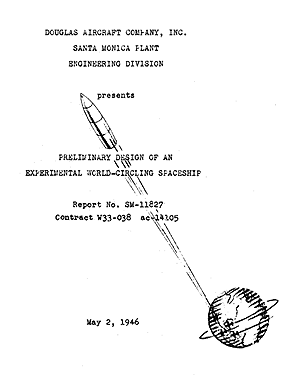The RAND World-Circling Spaceship
and the 1948 Chiles-Whitted "rocketship" sighting
In May, 1945, when hostilities had barely ended in Europe, Wernher von Braun issued a report on German missile progress for the benefit of his new American employers, with special emphasis on the possibility of launching an artificial earth satellite vehicle. The US Navy took particular interest in this concept, and by November 1945 the Bureau of Aeronautics produced its own study of the technical feasibility of such a project.
Called High Altitude Test Vehicle (HATV), the Navy's BuAer rocket was an extremely ambitious design for its time, based on use of high-energy liquid hydrogen fuel and designed to fly directly from the Earth's surface into orbit as a single stage vehicle (a feat which has yet to be accomplished). The HATV designers managed to free themselves from the hold of the safe, proven design of the V-2 and created a set of refreshingly daring and original (but impractical) plans.








